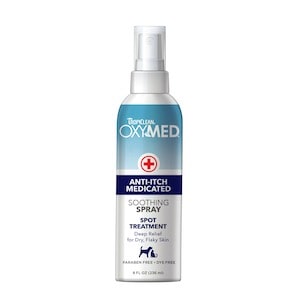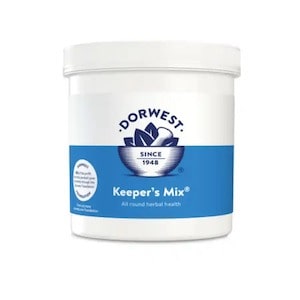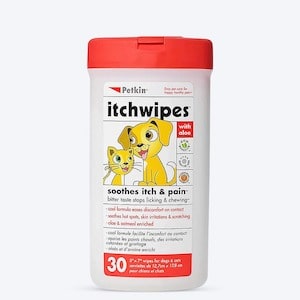Sudocrem is a popular product among parents, as it can help soothe and heal nappy rash in babies. But did you know that some dog owners also use Sudocrem for their dog’s skin problems?
Sudocrem claims to have soothing, antiseptic, and protective properties, which can benefit dogs with minor wounds, rashes, or allergies. However, Sudocrem also contains zinc oxide, which can be harmful to dogs if swallowed. So, is Sudocrem safe and effective for dogs? In this article, we will explore the pros and cons of using Sudocrem for dogs, and provide some tips on how to use it properly.

Key Takeaways
- Sudocrem is a healing cream for various skin conditions, originally designed for nappy rash in babies.
- Sudocrem can be used for dogs to treat minor wounds, rashes, or allergies, but it should be used sparingly and carefully.
- Sudocrem contains zinc oxide, which can be toxic to dogs if ingested in large quantities, causing zinc toxicosis
You Might Also Like:
Can You Use Sudocrem on Dogs?
Yes, Sudocrem can be applied to dogs for minor wounds, rashes, or allergies. However, caution is essential due to the presence of zinc oxide, which can be harmful if ingested. Carefully monitor your dog to prevent licking or swallowing the cream.
Sudocrem is a popular and effective cream for soothing sore skin, eczema and acne. It is a type of soothing cream initially manufactured in Dublin and introduced to the UK in the 1970s. This medicated cream was originally designed to be used to relieve nappy rash in babies.
It has a water-repellent base which forms a protective barrier, therefore helping to stop any irritants coming into contact with the skin. In addition, the emollient effect of Sudocrem can help to soothe sore inflamed skin whilst leaving the skin feeling soft. It can also be used to treat eczema, bedsores, minor burns, surface wounds, sunburn and chilblains.
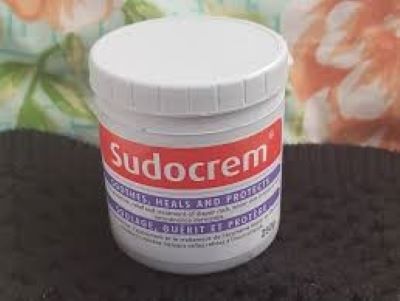
Sudocrem is an over-the-counter cream. You don’t need a prescription to buy it. It can also be used for other skin conditions that require a soothing, protective antiseptic cream with additional healing, antibacterial and antifungal properties.
Active Agents in the Sudocrem
Before using Sudocrem on your dog, it’s important to know the ingredients and activating agents present in it. This knowledge can help you protect your dog and prevent any adverse reactions in case your dog is allergic to any of the components used in the cream.
The primary components in the cream are:
- Zinc Oxide
- Anhydrous Hypoallergenic Lanolin
- Benzyl Alcohol
- Benzyl Benzoate(acts as fragrancing agent)
Zinc Oxide
Although zinc oxide is safe to apply to your dog’s skin, it can be very toxic if ingested and can cause serious harm to your furry friend. This is why it’s necessary to look after your dog when dealing with Sudocrem. You should ensure that the dog does not lick the cream or swallow it in large quantities.
Zinc oxide works to form a barrier on the skin. This barrier protects the skin from irritation, as well as provides moisture. This must be used only on the skin of dogs. It is not meant for ingestion, which is perhaps where the concern comes for dogs since they lick themselves often. However, if used appropriately, a dog should be perfectly fine.
Anhydrous Hypoallergenic Lanolin
Anhydrous hypoallergenic lanolin works as a moisturizer in the cream that soothes and softens the skin. It forms an oily layer that retains moisture, eventually reducing irritation and itchiness caused by the skin. Hence, it is considered safe for a dog.
Benzyl Alcohol
Benzyl alcohol is used as a local anaesthesia and antiseptic. It cleanses the wound and helps protect it from bacterial infection. Thus, it would be of great benefit to your dog. It also works as a preservative to keep the Sudocrem last for a longer time.
The cream has a mild composition of Benzyl alcohol and hence has low toxicity and low vapour pressure. It can be naturally found in fruits and teas but can also be made synthetically. It is a natural substance and is safe when applied and used correctly in creams.
How to Use Sudocrem on Dogs?
Your dog may have experienced cuts, burns, sores, ulcers or skin allergies. For such skin changes we humans use sudocrem. But, can you use Sudocrem on dogs? The answer to this is definitely a Yes! You can use Sudocrem on your dog.
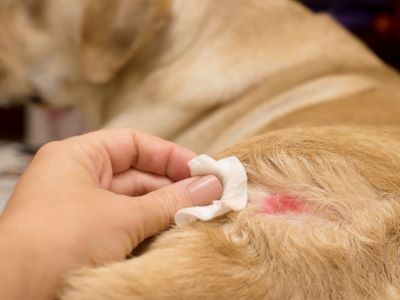
You can apply this cream to the dog’s paws, tail, belly, back, and legs. But, when applying Sudocrem to your dog’s body, keep in mind that the cream will not be absorbed immediately, since this cream contains a water-repellent base. Try applying a thin layer of cream on the skin and let it absorb completely till the dog continue moving.
Avoid this cream near sensitive parts of your dog like eyes, ears, lips and nose. So, if your dog has got a red nose due to some injury, you can’t apply Sudocrem there. It is better to consult a veterinarian in such cases.
Always watch your dog when you apply Sudocrem as it would be dangerous if the dog swallow or lick the cream. Though a small amount of intake does not have an adverse effect, it is better to completely avoid it. You can stop your dog from licking or covering the affected area depending on the wound.
An Elizabethan collar is the most preferable way to prevent your dog from licking off the Sudocrem. You may try putting the cone on your dog for the first 15-20 minutes after the application of cream to allow it time to absorb into the skin.
Never apply the cream at night as you won’t be able to keep an eye on your dog and he may lick and swallow the cream. Also, make sure you are home and available to monitor your dog after Sudocrem is applied. If your dog licks and ingests a large amount of Sudocrem, it could have dangerous results and worsen the situation.[1]
When to Use Sudocrem for Dogs?
Sudocrem has been used as a multi-purpose ointment cream for us. The same goes for dogs! As per veterinarians, it can be used for various purposes for your dog to get quick relief from wounds. As mentioned before, Sudocrem can be a first-aid for your dog.
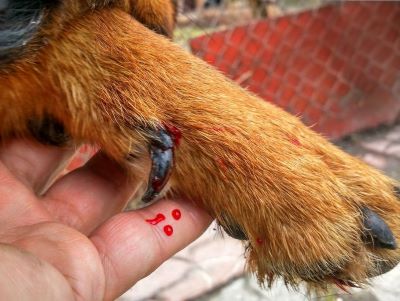
Sudocrem can be used in the following cases:
- Intensive scratching
- Small cuts
- For sun protection
- Flea bites
- Rectal itching
However, Sudocrem should not be used frequently. It is just for occasional use in case of emergency and quick relief to your dog. It is always advisable and recommended to consult a veterinarian and then act wisely as some dogs may be allergic to the components of the cream.
Any Side-effects?
Sudocrem is non-toxic for both humans as well as dogs but only for a safe application on the skin. Dogs commonly lick themselves to clean their body. Thus, there is a particular component you need to worry about that is Zinc Oxide.
According to Malcolm Weir and Ernest Ward at VCA hospitals, “It is important to prevent your dog from licking and swallowing any of these external preparations, as they may contain ingredients that could be harmful if swallowed.“
Zinc when applied on the skin serves a lot of benefits for the skin. However, if ingested it can have adverse effects. It can lead to a condition called zinc toxicosis or zinc poisoning. This is why we caution you to be very careful with the application.
The effects on the dog depend on the amount of cream ingested. A small amount will never make any difference. However, ingesting a large amount of zinc can have detrimental effects on the health of your dog. In such cases, looking for a vet would be the first priority.
Signs and symptoms of zinc toxicosis:
- Vomiting
- Lethargy
- Weight loss
- Weakness
- Anaemia
- Diarrhoea
- Cyanosis
It is possible to completely eradicate your dog from zinc toxicosis if caught and treated properly. Treatment is available and most of the dogs fully recover. Ultimately, zinc toxicosis is considered to have relatively good prognosis results if it is caught and treated promptly.[2]
FAQs
Can You Use Sudocrem on Dogs?
Vets have shown that it is safe to use Sudocrem on dogs in small quantities. A dog’s skin can be a breeding ground for bacteria, which can cause all sorts of problems from minor skin irritation to major infections.
What are the side effects of Sudocrem?
Potential side effects of Sudocrem include itching and burning at the site where it’s applied. This may happen if you’re allergic to any of the ingredients in Sudocrem. Sudocrem contains zinc oxide which is highly toxic to birds. Zinc oxide is also toxic to dogs and cats if ingested in large quantities, but applying a thin layer of Sudocrem to sore or irritated skin is generally safe and can be beneficial.
Can I put Sudocrem on my dog’s cut?
Yes, Sudocrem is safe to use on minor scrapes and scratches. Sudocrem can help soothe minor cuts and grazes thanks to anhydrous hypoallergenic lanolin, which soothes and softens the skin and zinc oxide, which helps reduce the loss of fluid from the skin. Benzyl alcohol, which is an antiseptic and anaesthetic and reduces discomfort. However, if the scape or cut is anything more than minor, it is best to consult your veterinarian.
Overview
So, can you use Sudocrem on dogs? Well, looking at a larger picture, Sudocrem is completely acceptable for home treatment of certain skin changes. Moreover, many vets advise doing so for the comfort and relief of the dog.
Sudocrem is entirely safe and effective for both dogs and humans. However, dogs instinctively want to scratch, lick and bite at a source of pain and irritation. This is when it can be dangerous. Hence, you should be more careful while using it for your canine. Otherwise, you may want to consider a cream designed specifically for dogs.
References:
- Vet Tech Corner: Zinc oxide ingestion. (2023) from ASPCApro
- Siow, J. W. (2018). Zinc toxicosis in a dog secondary to prolonged zinc oxide ingestion from National Institute of Health
